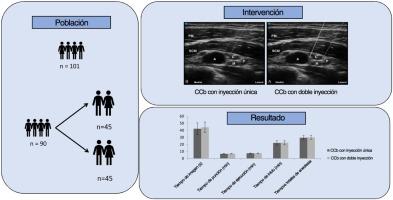肋锁关节阻断单次注射(角袋技术)与双次注射的比较研究:随机非劣效性平行臂试验。
IF 0.9
Q3 ANESTHESIOLOGY
Revista Espanola de Anestesiologia y Reanimacion
Pub Date : 2024-10-01
DOI:10.1016/j.redar.2023.08.008
引用次数: 0
摘要
背景以前的研究表明,超声引导下的肋锁阻滞可能需要双针才能提供充分、快速的感觉和运动阻滞。在本试验中,我们假设在进行单次肋锁关节阻滞时,如果使用角袋方法(腋动脉和正中脊髓之间)而不是中央方法(三条脊髓的中点),阻滞的开始时间将不会劣于双针技术。方法在一家三甲医院接受上肢手术的 90 名患者被随机分为两组,接受超声引导下的肋锁关节阻滞(CCB)。一组在超声引导下使用角袋法进行单次阻滞,另一组在超声引导下进行双次阻滞--第一次阻滞在三条脊索的中心,第二次阻滞在腋动脉和正中脊索之间。结果 在101名通过资格评估的患者中,有90人在一年内(2022年2月至2023年1月)被招募,每组45人。单发组的发病时间为 22.1±3.1 分钟,双发组为 22.4±2.9 分钟。结论单发角袋CCB和双发CCB的阻滞起始时间和完全麻醉时间相似。需要进一步研究以确定所述技术所需的最小有效局麻药量。本文章由计算机程序翻译,如有差异,请以英文原文为准。

Estudio comparativo entre el bloqueo costoclavicular con inyección simple (con técnica corner pocket) y con doble inyección: ensayo aleatorizado de no inferioridad y de brazos paralelos
Background
Previous studies have shown that ultrasound-guided costoclavicular block may require a double shot to provide adequate, rapid sensory and motor blockade. In this trial, we hypothesized that if the corner pocket approach (between the axillary artery and median cord) is used instead of the central approach (at the midpoint of the 3 cords) when performing single-shot costoclavicular block, the onset of blockade would be non-inferior to the double-shot technique.
Method
Ninety patients undergoing upper limb surgery were randomized to 2 groups for ultrasound-guided costoclavicular block (CCB) at a tertiary hospital. One group received ultrasound guided single-shot CCB using the corner pocket approach and other received ultrasound guided double-shot – the first shot at the centre of the 3 cords and the second between the axillary artery and the median cord. An observer blinded to group assignment recorded blockade onset time (defined as the time required to achieve a minimal sensorimotor composite score of 14 out of 16 points).
Results
Of the 101 patients assessed for eligibility, 90 were recruited over 1 year (February 2022 to January 2023), with 45 in each group. Onset time was 22.1±3.1 min in the single-shot group and 22.4±2.9 min in the double-shot group. This difference was insignificant (p=0.3).
Conclusion
Time to onset of blockade and full anaesthesia are similar in single-shot corner pocket CCB and double-shot CCB. Further studies are required to determine the minimum effective volume of local anaesthetic required for the described technique.
求助全文
通过发布文献求助,成功后即可免费获取论文全文。
去求助
来源期刊

Revista Espanola de Anestesiologia y Reanimacion
ANESTHESIOLOGY-
CiteScore
1.80
自引率
15.40%
发文量
113
审稿时长
82 days
 求助内容:
求助内容: 应助结果提醒方式:
应助结果提醒方式:


